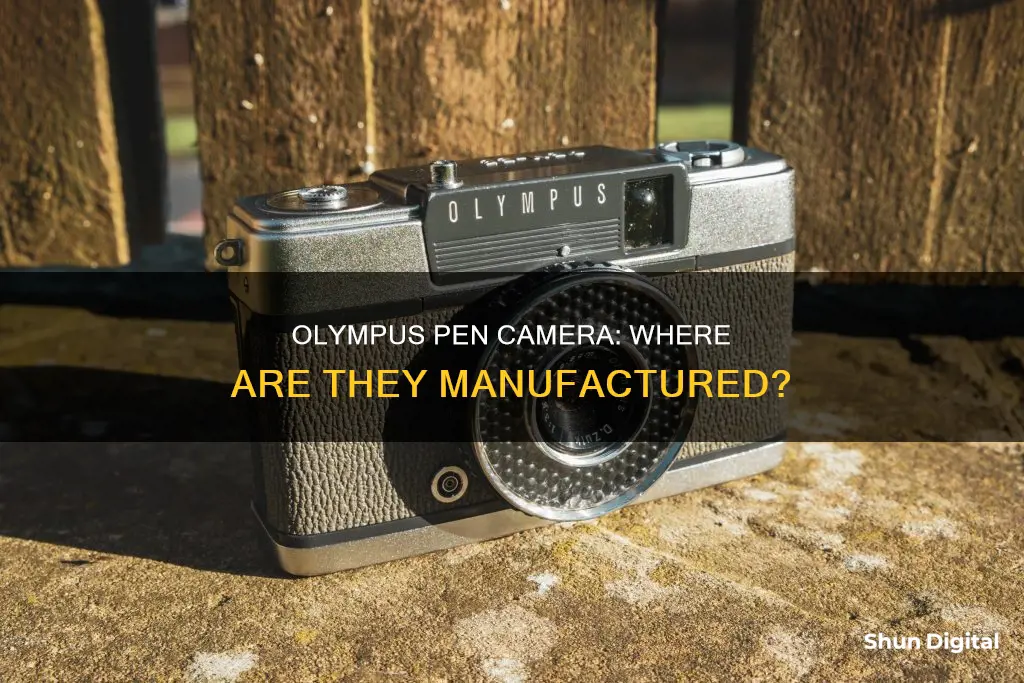
The Olympus Pen camera was initially introduced in 1959 and was the first half-frame camera produced in Japan. The original Pen was designed by Yoshihisa Maitani and was one of the smallest cameras to use 35mm film in regular 135 cassettes. The name was derived from the idea that the camera was as portable as a pen. The Pen series included a range of derivatives, such as the Pen EE with automatic exposure and the Pen D with a wider aperture lens. The production of the simpler models of the Pen family continued until at least 1983. Today, the Digital PEN series by Olympus offers mirrorless interchangeable lens digital cameras.
What You'll Learn
- The original Olympus Pen was released in 1959 and was the first half-frame camera produced in Japan
- The Pen was designed by Yoshihisa Maitani, who wanted to create a simple camera that could be used by women
- The Pen was one of the smallest cameras to use 35mm film in regular 135 cassettes
- The Pen W or Pen Wide is a rare variant of the Pen S model with a wide-angle 25mm lens
- In 2009, Olympus released the first digital Pen camera, the PEN E-P1

The original Olympus Pen was released in 1959 and was the first half-frame camera produced in Japan
The Olympus Pen is a half-frame camera that uses 35mm film. The first-generation Olympus Pen was released in 1959 and was the first half-frame camera produced in Japan. It was designed by Yoshihisa Maitani, a young junior-level engineer at the time, who wanted to create a camera that was simple, compact, and catered to women, as men accounted for 98% of the market at the time. Maitani's design was initially balked at by the Olympus Factory Manager, who saw it as a "simple toy" and refused to produce it. However, after building a prototype, Maitani was able to convince the head of the sales division to give his idea a chance.
The original Olympus Pen was a very compact half-frame camera with just a viewfinder, no meter, and fully manual settings. It featured a 28mm f/3.5 Zuiko lens and was one of the smallest cameras to use 35mm film in regular 135 cassettes. It was designed to be as portable as a pen, hence the name. The camera was a success, with over 8 million units sold, and it paved the way for the legendary Pen F Series half-frame single-lens system and other Olympus classics.
The original Pen was followed by a series of derivatives, some of which introduced exposure automation, such as the Pen EE, while others offered a wider aperture lens and a manual meter, like the Pen D. The Pen S, released in 1960, offered an upgraded D.Zuiko 30mm F2.8 lens. The Pen D, launched in 1962, was the top model in the Pen range at the time, featuring a high-performance F1.9 large-aperture lens, a high-speed shutter, and a built-in exposure meter.
The Olympus Pen F, introduced in 1963, was a significant innovation as it was the world's first 35mm half-frame SLR camera. It featured a vertical 18x24mm format compared to the usual horizontal 35mm format, allowing for 72 photos to be taken on a standard roll of 35mm film. The Pen F was replaced by the PEN-FT in 1966, which included a built-in light meter.
Unlocking the P30 Camera: Exploring the Different Modes
You may want to see also

The Pen was designed by Yoshihisa Maitani, who wanted to create a simple camera that could be used by women
The Olympus Pen was designed by Yoshihisa Maitani, who joined Olympus Optical Co., Ltd. (now Olympus Corporation) in 1956 as a camera designer. Maitani was a passionate photographer himself, and his goal was to design a camera that would be simple to use and cater to women, as men accounted for about 98% of the market at the time. He wanted to break the stereotype that cameras had to be complicated machines with lots of controls.
Maitani's design philosophy was centred around simplicity and quality. He believed that ""the lens is the soul of the camera"" and wanted to create a camera with an exceptional lens that could rival the Leica IIIf, a camera he owned and used frequently. Maitani worked closely with the lens designers at Olympus to create the D-Zuiko lens, which was known for its incredible sharpness and performance.
The original Pen, introduced in 1959, was a half-frame camera, one of the smallest cameras to use 35mm film in regular 135 cassettes. It featured a compact design, a viewfinder, no meter, and fully manual settings. It was named the "Pen" because of its portability—it was thought to be as portable as a pen.
Maitani faced opposition from within Olympus for his simple design, with some believing it was just a toy. However, he persisted and eventually convinced the head of the sales division to give his idea a chance. The original Pen became a massive success, selling over 17 million units during its production run.
Following the success of the original Pen, Maitani and his team developed several derivatives, such as the Pen EE, an amateur model with automatic exposure and fixed focusing, and the Pen D, a more expensive model with a wider aperture lens and a manual meter.
Maitani's influence extended beyond the Pen series. He also designed the Olympus OM-1 (also known as the M-1), a
Maitani's designs revolutionised the camera industry and set new standards for size, weight, and performance. His philosophy of combining "the ability to take great photographs with compactness, ease of use, and affordability" continues to inspire Olympus's camera designs today.
Campark Cameras: Where Are They Manufactured?
You may want to see also

The Pen was one of the smallest cameras to use 35mm film in regular 135 cassettes
The Olympus Pen, introduced in 1959, was the first half-frame camera produced in Japan. Designed by Yoshihisa Maitani, the Pen was one of the smallest cameras to use 35mm film in regular 135 cassettes. The 135 film, also referred to as 35mm film, is a type of photographic film with a film gauge of 35mm loaded into a standardised cassette or cartridge. The term 135 was introduced by Kodak in 1934 for still photography and quickly became the most popular photographic film size, a position it still holds today.
The original Pen was a very compact half-frame camera, featuring a simple rear-winding mechanism, an Olympus D.Zuiko lens known for its image and rendering quality, and an attractive, user-friendly design. The Pen was designed to be portable, with Maitani aiming to create a camera as portable as a pen—hence the name. This focus on simplicity and portability set the Pen apart from other cameras on the market at the time, which often featured complicated controls and were marketed primarily towards men.
The Pen's compact size and ease of use contributed to its popularity, leading to the development of the legendary Pen F Series half-frame single-lens system. The original Pen Series half-frame film cameras sold over 17 million units cumulatively. The Pen's success also paved the way for other iconic Olympus camera series, such as the OM and XA.
In addition to its portability, the Pen offered a unique vertical 18x24mm format compared to the standard horizontal 35mm format. This allowed users to take 72 photos on a standard 36-exposure roll of 35mm film, essentially halving the cost per photo. This feature made the Pen particularly well-suited for street photography and encouraged photographers to approach subjects differently.
The Pen's compact size, innovative features, and impact on the camera industry have earned it a cult following. Today, it is considered a classic and continues to be sought after by collectors.
Exporting Camera Raw Presets: A Step-by-Step Guide
You may want to see also

The Pen W or Pen Wide is a rare variant of the Pen S model with a wide-angle 25mm lens
The Pen W is a half-frame camera, which means that when holding the camera in a "landscape" position, you are actually shooting in a "portrait" orientation. This can take some getting used to and requires rotating the camera 90 degrees to shoot in a true landscape orientation. The camera has a film counter dial, which, while a bit old-school, adds to its charm. The shutter speed is controlled by a silver ring around the lens, which may be unfamiliar to some photographers. The Pen W has a comfortable grip, allowing users to place their index finger on the shutter and their thumb on the film advance. It also has 7ft and 15ft focus marks that snap into place for quick zone focusing.
The Pen W is known for its exceptional build quality, with smooth winding gears and a luxurious feel. Its compact size makes it perfect for street photography and travelling, as it can easily fit into a purse or jacket pocket. Despite its small size, the Pen W has advanced features, including a six-element, semi-wide-angle Zuiko 25mm (f2.8 – 22) manually-focusing lens, a built-in tripod socket, a cable release socket, and PC connection. However, its top shutter speed of 1/250th may not be sufficient for some fast-paced street photography scenarios.
The Olympus Pen W is a highly sought-after collector's item and a technical marvel of engineering that has earned its cult status and place in photographic history.
Exploring the HDF Mode S8 Camera
You may want to see also

In 2009, Olympus released the first digital Pen camera, the PEN E-P1
The E-P1 is an interchangeable lens camera, utilising the Micro Four Thirds format, which allows for a smaller body while maintaining the same image sensor size as Olympus' DSLR models. This meant that the E-P1 delivered DSLR-quality images in a much more portable package, making it ideal for spontaneous photography and everyday use.
The camera features a 12.3-megapixel Live MOS image sensor, which provides excellent dynamic range, accurate colour fidelity, and advanced noise reduction for superior low-light performance. It also includes in-body image stabilisation, a proven dust reduction system, and a TruePic V image processor, enhancing image clarity and colour accuracy.
The E-P1 offers in-camera creative features such as art filters, multi-aspect ratios, and multiple exposure options, allowing users to apply unique effects to both still images and videos. It also has a 3-inch HyperCrystal LCD screen, providing a clear and detailed display for composing and reviewing shots.
One of the key appeals of the E-P1 was its retro-chic look, with a high-end stainless-steel body available in silver or white, reminiscent of classic cameras from the 1960s and 1970s.
The E-P1 was designed to be as compact as possible, which led to the omission of a built-in viewfinder and flash. While this may have been a drawback for some, Olympus offered optional accessories to address these absences, such as the FL-14 flash unit.
Overall, the Olympus PEN E-P1 was a groundbreaking camera, offering DSLR-level image quality in a sleek, portable package, and introducing innovative features that would shape the future of mirrorless cameras.
Point-and-Click Camera Batteries: Are They Lithium-Based?
You may want to see also







